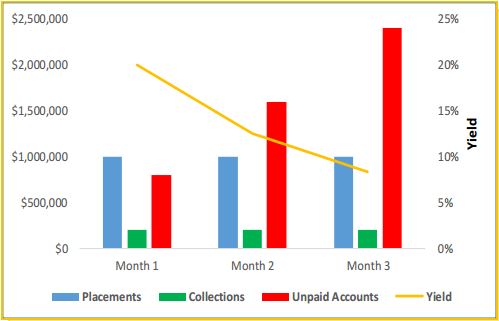Many recent news reports indicate a rise in the number of people selecting health insurance plans with high copayments and deductibles. This variation in cost sharing will require hospitals to collect higher sums to cover patients’ increased responsibility. Expectedly, providers are finding it more challenging to collect growing amounts from multiple sources, rather than dealing with just a few insurers. This pattern is likely to become more noticeable as time progresses.
With more and more patients enrolling in insurance plans that require them to pay more out of pocket, managing accounts receivable will be increasingly difficult. Many interested parties, including credit-rating agencies, are becoming actively aware of these challenges and will be monitoring how hospitals handle their collection responses to them. As a result, bad debt write-offs will become an increasingly more critical financial indicator.
What Hospitals Are Doing About It
Most hospitals are not staffed or equipped to collect relatively small amounts on increasingly larger numbers of patient accounts. As the number of patient accounts increases, so will the number of patient accounts that go unpaid. Hospital executives know that the best time to collect payments due from patients is prior to providing medical services. So, while hospitals invest in improving their pre-service collection capabilities, they very often alleviate their bottlenecks by using early-out firms to collect current patient accounts and then turn bad debt accounts over to contingency collection agencies.
What’s Really Happening
Hospital executives are usually satisfied with returns from their collection agencies because they’re consistent and, therefore, useful for managing finances. But it’s often overlooked that their pool of unpaid accounts grows larger and larger each month. Monthly liquidations are consistent, but the yield on the total pool shrinks each month.

The chart depicts that if a collection agency liquidates 20% of $1M placed with them each month, the hospital gets $200K each month. After three months, the hospital will have gotten $600K, but the pool of still-unpaid accounts will have grown to $2.4M. The yield for the first month was 20%, but the yield for the second month shrunk to 12.5%, and the yield for the third month is only 8.3%. Equally important – there’s still untapped value in the $2.4M pool of unpaid accounts.
Contingency collection agencies are staffed and equipped to work on newer accounts. It’s too costly for them to re-contact patients after 60 days or so. Instead they focus their time and resources on the newer accounts they continuously receive from their hospital clients. In fact, 80% of collections come from accounts placed with collection agencies within the past 60 days.
What Hospitals Aren’t Doing – But Should Do
With the pool of unpaid patient accounts getting larger each month and the incentive for collection agencies to only work newer accounts, it’s worthwhile for every hospital to get a valuation of their entire pool of patient accounts in bad debt status. Very few hospital executives or board members have any idea of the potential value of these assets.
What We Do for Hospitals
Dedicated exclusively to healthcare providers, C&E Acquisition Group provides capital and expertise to maximize the value of our clients’ patient accounts. By doing so, we help our clients fulfill their missions and improve the health of the communities they serve.
Compliant, professional and caring, C&E Acquisition Group respects the provider-patient relationship while helping our clients get all the revenue they deserve for providing high-quality care to patients.
Knowledge is Power – Contact us today about a no-cost, no-obligation evaluation of your bad debt patient accounts.
Want to refer back to this information at a later date? You can download a print-friendly version of the article here.




